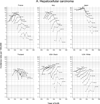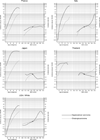International trends in liver cancer incidence, overall and by histologic subtype, 1978-2007
- PMID: 27244487
- PMCID: PMC5310166
- DOI: 10.1002/ijc.30211
International trends in liver cancer incidence, overall and by histologic subtype, 1978-2007
Abstract
Primary liver cancer, the most common histologic types of which are hepatocellular carcinoma (HCC) and intrahepatic cholangiocarcinoma (ICC), is the second leading cause of cancer death worldwide. While rising incidence of liver cancer in low-risk areas and decreasing incidence in some high-risk areas has been reported, trends have not been thoroughly explored by country or by histologic type. We examined liver cancer incidence overall and by histology by calendar time and birth cohort for selected countries between 1978 and 2007. For each successive 5-year period, age-standardized incidence rates were calculated from volumes V-IX of the Cancer Incidence in Five Continents electronic database (CI5plus) and the newly released CI5X (volume X) database. Wide global variations persist in liver cancer incidence. Rates of liver cancer remain highest in Asian countries, specifically Eastern and South-Eastern Asian countries. While rates in most of these high-risk countries have been decreasing in recent years, rates in India and several low-risk countries of Africa, Europe, the Americas, and Oceania have been on the rise. Liver cancer rates by histologic type tend to convey a similar temporal profile. However, in Thailand, France, and Italy, ICC rates have increased while HCC rates have declined. We expect rates in high-risk countries to continue to decrease, as the population seroprevalence of hepatitis B virus (HBV) continues to decline. In low-risk countries, targeted screening and treatment of the hepatitis C virus (HCV), treatment of diabetes and primary prevention of obesity, will be key in reducing future liver cancer incidence.
Keywords: incidence; international; liver cancer; trends.
© 2016 UICC.
Figures
References
-
- Ortman J, Velkoff V, Hogan H. An Aging Nation: The Older Population in the United States. U.S. Census Bureau. 2014
-
- Okuda K, Nakanuma Y, Miyazaki M. Cholangiocarcinoma: recent progress. Part 1: epidemiology and etiology. Journal of gastroenterology and hepatology. 2002;17:1049–1055. - PubMed
-
- London WT, McGlynn KA. Liver Cancer. In: Schottenfeld D, Fraumeni JF, editors. Cancer epidemiology and prevention. 3rd. Oxford; New York: Oxford University Press; 2006. pp. 763–786.
Publication types
MeSH terms
Grants and funding
LinkOut - more resources
Full Text Sources
Other Literature Sources
Medical






